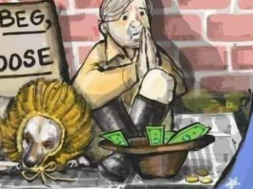
Roving Periscope: Shahbaz adds $8 bn Saudi debt to Pakistan’s $ 85.6 bn foreign loans
Virendra Pandit
New Delhi: Last week, Pakistan’s 20-day-old new Prime Minister, Mian Muhammad Shahbaz Sharif, began his 40-member entourage’s Saudi Arabian pilgrimage amid chanting of Chor, Chor slogans by the angry Pakistani pilgrims in Medina, and returned with a fresh USD 8 billion lifelines for his near-bankrupt country’s gasping economy.
During his Saudi visit, Shehbaz’s son, Hamza, 47, took an oath on April 30 as the new Chief Minister of Pakistan’s Punjab.
According to media reports, the Saudis agreed to provide Pakistan with a “sizeable package” to help Islamabad bolster its dwindling foreign exchange reserves and revive its ailing Sri Lanka-type economy.
Every few months, the cash-strapped, terrorist-infested country has been going like a pendulum between its bailout benefactors such as China, Saudi Arabia, the UAE, and the International Monetary Fund (IMF).
The fresh financial package may keep the Pakistani economy afloat for a few weeks. The South Asian country is facing a growing economic crisis, including high inflation, plummeting forex reserves, a widening Current Account Deficit (CAD), and a depreciating currency.
Pakistan requires financial help of between USD 9 and12 billion until June 2022 to avert further depletion of foreign currency reserves, the media reported.
The Saudi package deal includes a doubling of the oil financing facility, additional money either through deposits or Sukuks, and rolling over of the existing USD 4.2 billion facilities.
While Sharif left Saudi Arabia after pilgrimage and meetings, Pakistan’s Finance Minister Miftah Ismail stayed back to complete the financial package.
He tweeted, “Just said goodbye to Prime Minister Shehbaz Sharif and other colleagues at Jeddah Airport, who are on their way to Islamabad after a brief stopover in Abu Dhabi to meet Crown Prince Muhammad Bin Zayed. I remain in SA to meet Saudi officials and start technical-level talks.”
In December 2021, Riyadh provided USD 3 billion deposits to the State Bank of Pakistan. They operationalized the Saudi oil facility from March 2022, providing Pakistan with USD 100 million to buy oil.
In the last tenure of the Pakistan Muslim League (N) government (2013 to 2018), led by Shehbaz’s elder brother Nawaz Sharif, Saudi Arabia had provided Pakistan with a USD 7.5 billion packages.
Under the next regime, headed by Imran Khan (2018-2022), the Saudis provided a package of USD 4.2 billion, including USD 3 billion deposits and a USD 1.2 billion oil facility for one year and linked it with an IMF program.
That helped little and the country’s economy plummeted further. Shattering the previous record of USD 10.45 billion, Islamabad got USD 15.32 billion in new foreign loans in the fiscal year 2020-21, thus doubling Pakistan’s external debt in just three years. It added USD 35.1 billion to take the total figure to an astonishing USD 85.6 billion.
Official reports said it added the new debt to mitigate the pressure on the CAD, strengthen foreign exchange reserves, enhance external debt servicing capacity and provide requisite financing to water sector development.
Under the Imran Khan government, the Pakistani rupee depreciated 30.5 percent against the US dollar. Its value fell from Rs 123 against the USD in August 2018 to Rs 177 in December 2021, a decline of 30.5 percent over the preceding 40 months. This made it one of the highest devaluations of the currency in the country’s history.
The only other higher devaluation had occurred after the fall of Dhaka in 1971. Pakistan’s currency was devalued by 58 percent from Rs 4.60 to Rs 11.10 against the USD in 1971-72.
On Monday, a US dollar was worth PKR 185.7














